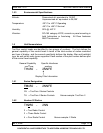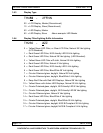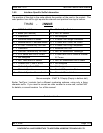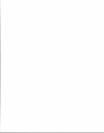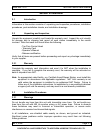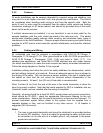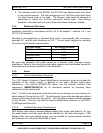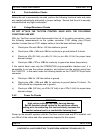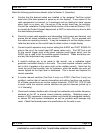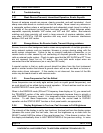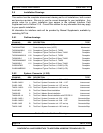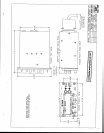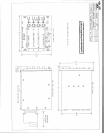
SM06 Rev. 4.10 Tac/Com Control Head Manual
Make the following performance checks (refer to Section 3, Operation):
a) Confirm that the desired radios are installed in the assigned Tac/Com control
head slots (this data appears at power-up on the display). If any aspect of the
radio assignments is incorrect, or if messages such as 'waiting for slave' appear
when there is no slave, etc., the set-up of the control head may be incorrect.
Consult the Installation Configuration Mode section of this manual (Section 3.12),
or contact the Product Support department at NAT for instructions on how to alter
this data before proceeding.
b) Check for correct radio operation and channelling, both receive and transmit, and
ensure that all status indications are correct (TX and RX). Do not proceed until
the radios are operating correctly. It may be necessary to set the display screen
(after the last radio) on the control head to obtain a clear or bright display.
c) Correct squelch operation may require setting the AUDIO and FAST SQUELCH
pots on the top of the control head (NT-series radios only). The FAST pot is set
for the correct trigger point of the panel indicator (scan trigger point), and the
AUDIO pot is used to set the audible squelch threshold. These are factory set,
and any field adjustment may cause problems.
d) If squelch settings are to be made in the aircraft, use a calibrated signal
generator connected directly to the radio. The visual squelch indicator must be
set so that it appears at the same point as the audible squelch. Note that the
visual trip point (fast squelch) has no hysteresis, while the audible trip point will
remain tripped as the input level is decreased. This is normal and required for
correct operation.
e) If remote channel switches (Tac/Com II only) or a DTE12 (Tac/Com II only) are
installed, confirm that all remote channelling and editing functions are working.
All of these connections are via the system connector, J100/P100. DTE12 data
is serial, while the external remote switches are ground closures (pulled up to
+5 V internally).
f) Check each antenna feedline with a through-line wattmeter and suitable frequency
elements at the RT to ensure correct antenna matching. Reflected power in
excess of 25% represents a serious problem and should be investigated carefully,
or serious RFI and system interference as well as possible radio damage may
result. Check that forward power is to specifications for the radio in use.
Jan 4, 2006 Page 2-5
ENG-FORM: 805-0108.DOT
CONFIDENTIAL AND PROPRIETARY TO NORTHERN AIRBORNE TECHNOLOGY LTD.



